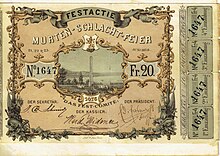Battle season
As battle year or battle year is known in particular in the area of the Old Confederacy church memorial services for the fallen soldiers of battles and wars . There were also corresponding celebrations outside of the Confederation.
history

In the course of the late Middle Ages , the authorities of the federal places began to donate seasons for the fallen of past armed conflicts so that anniversaries or other significant dates could be prayed for their souls every year. Originally, these celebrations were not celebrated on the spot, but in the local parish churches . Usually the names of the fallen were recorded in the yearbooks together with a short report on the events in order to proclaim them as part of the liturgical remembrance of the dead . In many cases, however, such records were not made immediately after the battle, so that a detailed source-critical examination is necessary.
The date of the battles near Laupen and Murten , namely the day of the ten thousand knights (June 22), established itself as the most important holiday in many federal locations . The day of St. Fridolin (March 6) was also celebrated in many places in memory of the Old Zurich War and especially the Battle of Ragaz .
After the fall of the Ancien Régime , this custom was abandoned in most places. It was replaced by more secular commemorations with festivals and shooting festivals , especially at the major centenary celebrations of the relevant events in the 19th and 20th centuries. The year in memory of the Battle of Sempach at the chapel there , the Näfelser Fahrt in Näfels and the pilgrimage of the Appenzell people in memory of the Battle of the Stoss are still celebrated every year today . The commemorations for the Battle of Morgarten are more recent.
literature
- Rainer Hugener: Bookkeeping for eternity. Remembrance of the dead, written down and tradition formation in the late Middle Ages. Chronos, Zurich 2014, ISBN 978-3-0340-1196-9 .
- Rainer Hugener: The Changing Place of Remembrance. The Sempach battle commemoration in the Middle Ages and in the early modern period, in: Der Geschichtsfreund. Journal of the Historisches Verein Zentralschweiz 165, 2012, pp. 135–171.
Web links
- Georg Kreis : Slaughter Seasons. In: Historical Lexicon of Switzerland .
- Georg Kreis : Commemorations. In: Historical Lexicon of Switzerland .
- Publications on slaughter seasons in the Opac der Regesta Imperii
Individual evidence
- ↑ See Klaus Graf : Battle Commemoration in the Late Middle Ages. Rites and media of the presentation of collective identity, in: Detlef Altenburg, Jörg Jarnut and Hans-Hugo Steinhoff (eds.): Festivals and celebrations in the Middle Ages. Paderborn Symposium of the Medievalist Association, Sigmaringen 1991, pp. 63–69.
